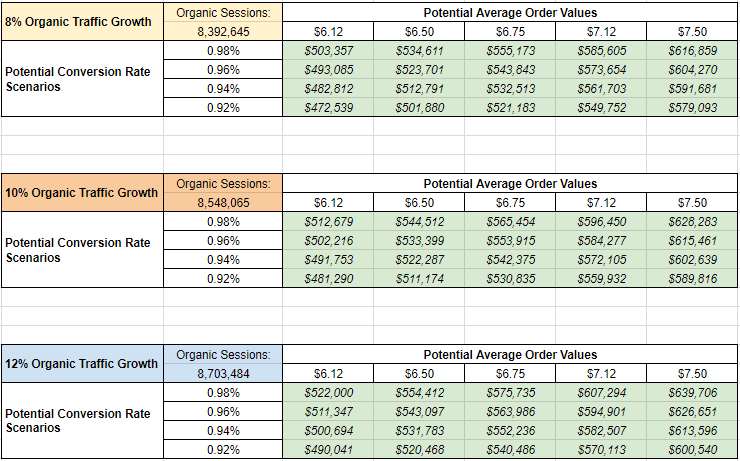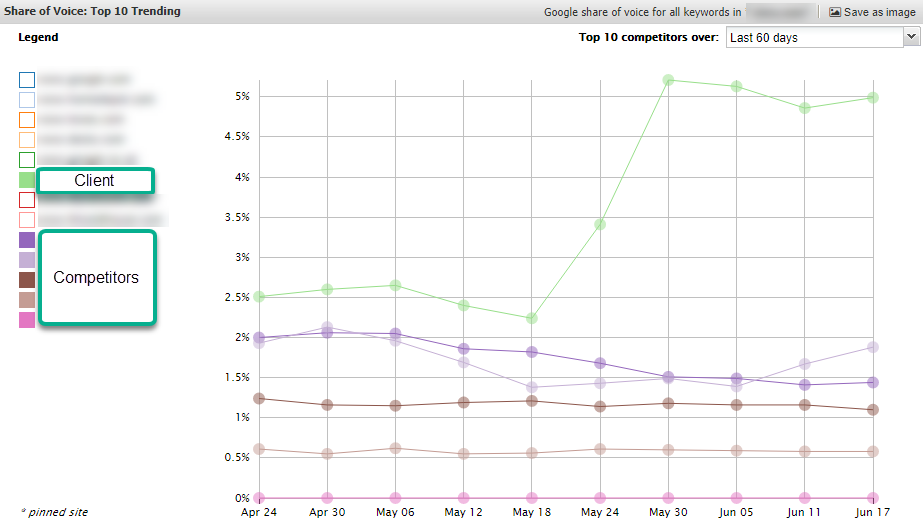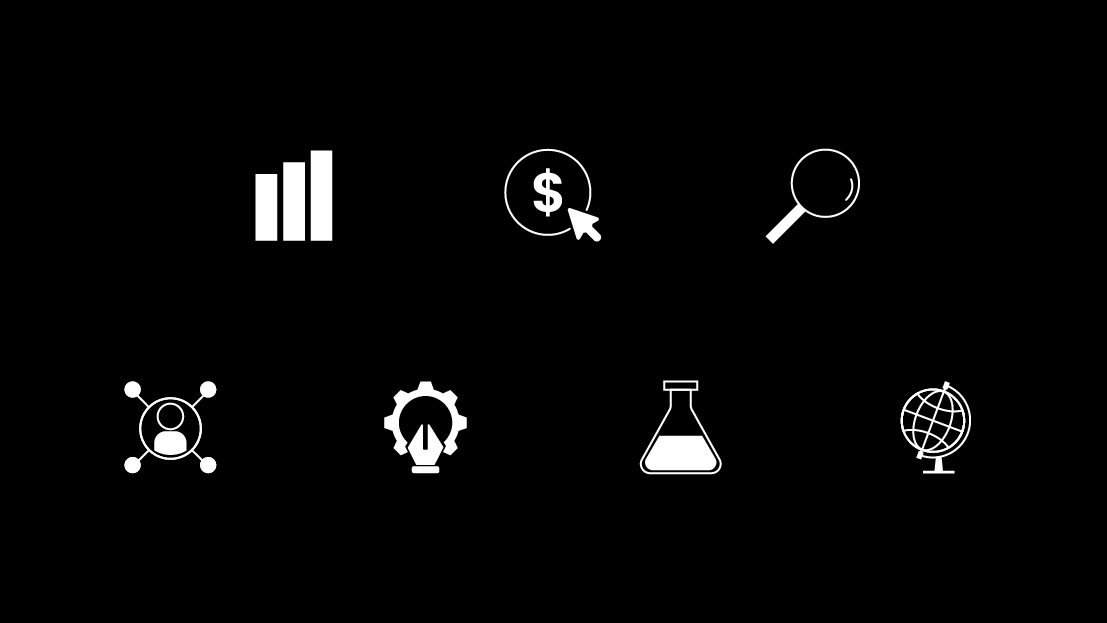As consultants, it’s our role to be a true partner to our clients to help them meet or exceed business goals. But what happens when your client is pushing for something you don’t agree is in the best interest of achieving those goals? Do you follow the mantra that “the client is always right?” Or do you own that a tough conversation is about to ensue, but one that can help guide the partnership down the path to success?
Below, we’ll walk through a couple scenarios that could come up in a day in the life at Seer.
Scenario 1: “We want to know the expected impact of SEO by X date”
This is a fair question. A client invests $X/month into a marketing channel and wants to know what the ROI might look like over some defined period of time. We all know that when it comes to SEO, it’s not easy to predict when that hockey stick growth is going to occur. Some common responses that are helpful to communicate:
- “We usually see an uptick in traffic/conversions/revenue about 2-4 months after you implement our recommendations.”
- “Organic growth completely depends on the industry, the seasonality, the site's current footprint/current position in the marketplace, and the competitiveness of the space.”
Fair starting points but not enough to satisfy the client’s question. The reality is there are too many variables to know exactly when the growth will occur and by how much. So how do you set a realistic performance expectation without shooting you and your team in the foot? Through projections.
It’s OK to make impact projections, and most of the time the client isn’t going to hold you accountable down to the dollar. They’re looking for a rough idea of when the investment is going to not only break even but start earning a return. And remember: the money they spent on your services could have gone somewhere else, so just keep in mind they’re likely always evaluating their investments.
There are multiple ways to create projections. The following options all have the same goal: provide your client a range of possible outcomes to help set performance expectations. Also worth noting: When you’re making these projections, it’s ideal to give a range of time it’ll take before you see these numbers, as well as a set of reasonable assumptions.
Create a good/better/best scenario
Is there a way to pull total potential opportunity across their entire marketplace? What better way to show expected impact than to first uncover the total opportunity for their products or services and work down from there?
Take all the target products, services or solutions (or isolate them by category) and pull out the total MSV across that entire section of the website. Use a variety of tools to pull keyword data and monthly search volume, remove duplicates and irrelevant keywords before you uncover the total monthly search opportunity. Alternatively, if the client is running paid search campaigns, consider leveraging impression data by search query.
From there, provide your client with a good/better/best scenario based on potential ranking position. Here’s how:
- Start with the total market opportunity you’ve just calculated through impression data or Adwords search volume.
- Find your client’s non-branded click-through-rate curve for your site, and apply your CTR model to your total market opportunity. This leaves you with projected traffic data. Play around with this model in a good/better/best framework—how much traffic might top-5 rankings drive? What about top 10?
- Apply your conversion rates to your projected traffic data, and conversion values to your project conversions.
Create a table of outcomes
There are many variables at play that will ultimately determine the organic revenue growth, but if you know the current conversion rate and dollar value of a conversion, you can create a table that helps visualize to your client some of the most important metrics and how they impact an outcome depending on different scenarios.
In the table below, we estimate three different organic traffic growth scenarios, but also show how revenue can be impacted if the existing conversion rate and/or average order value also improved along the way.

Market share growth or defense
Another angle to help set expectations can be to put together a market share report to show what your client currently owns and the potential impact to MSV if we grew to 5%, 10% or 15% by a certain month.
Find your total market share—this could be through all the priority keywords you track, all the queries you’re targeting, all the rankings your competitors own, all the ranking queries for a specific product or service, etc. This can be pulled through any of the typical ranking softwares like STAT or SEMrush.
Then tally up the total MSV, your client’s total ranking KWs (say, first two pages), and then total MSV of those rankings keywords. Then based on ranking position, we can calculate owned market share. Some programs already have a way they calculate market share so just be consistent with your model for before and after comparisons!
If your client currently owns a small piece of the pie (let’s hypothetically say 1%), you’d want to measure the potential organic traffic increase by expanding your market share to 5%. It’s not about one specific keyword or one specific ranking, but rather the measurement strategy and expectation is that it’s our job to focus on the bigger picture and look at things across an entire marketplace.
If your client currently owns a huge piece of the pie (let’s hypothetically say 35%), you’d want to measure the potential impact to defending market share. So, what are we gaining by keeping our market share at 35% and what would we stand to lose if we dropped 5% of our market share? It again shifts from looking at specific rankings or positions to looking at the entire market.
Before you share your projections, do they feel right to you?
Sometimes estimates can seem “off” even when the math is technically “right.” Listen to your gut if you find yourself pausing before hitting the send button. If what you’re about to share with your client doesn’t feel sound, there may be some other factors to consider.
- Are you basing your projections off of quality historical data? If your client has had tracking issues in the past, think twice before basing your growth targets off of untrustworthy data.
- Don’t have quality historical data, or starting from zero? Work with your client to get a feel for what they think a “good” month of traffic or revenue from organic search might look like. Is 100 visits per month “good”? 10,000? This can help you proactively set expectations around what is or isn't realistic. In this case, your “projections” might look less like a month-by-month breakout and more like a single, realistic end goal.
- Make a list of assumptions and dependencies to deliver with your projections. For example: The enclosed projections depend entirely on implementation within a week of delivery and assume proper implementation of recommendations. Doing this ensures up-front agreement that it will be a pretty big hill to climb, but that you absolutely won’t see any results without their help (see below for more on tracking assumptions!).
- Also consider what type of SEO work you’re doing and what can drive impact. Are there huge issues with the site technically that they can fix? Will there be a content push for top traffic driving pages? Account for these extra boosts in your projections and be sure to call them out in your assumptions and dependencies.
Scenario 2: “We would like keyword rankings as our primary KPI”
Oh boy. This is a tough one.
It’s far too common for clients to want to track progress of work on where a keyword ranks. It’s easy to track and quantify, and you can tie it to specific URLs that are being optimized. Makes sense, right?
Well, yes and no. Yes, it directionally shows you if your efforts are being rewarded by the search engines and helps you understand which strategies are or aren’t working. But what happens if those Page 1 rankings don’t get clicks? What happens if they get traffic but no conversions (or whatever action is expected if it’s a top-of-funnel page)? Would the project still be deemed a success?
There is also the scenario where you get X% of tracked keywords on Page 1 and they do get clicks and conversions. But what if the X% that earned Page 1 rankings were all the long-tail keywords with minimal search volume, and when you add up those conversions and their organic revenue, it’s not ROI positive. Is the project still considered a success?
When a client says “We’d like to see X% of the keywords we are tracking on Page 1 within X months,” here are some options for you to consider:
Educate your client on long-tail keywords not being tracked but making them money
In early 2018, Wil Reynolds put together a very in-depth article around SEO long-tail keywords. It’s a fascinating read, but most important to highlight for the topic of this current article was the research Wil did using a client’s PPC data.
For this specific client, Wil pulled all conversions at the search term level over the past 12 months, or 1.69M unique search terms. Of those search terms, 107K had assisted or received a direct conversion. And of those, 87K were unique converting keywords.
So what does this mean? Your client is getting conversions from long-tail keywords that you likely aren’t even tracking! We typically only track just a piece of the pie (again, because it just helps us understand directional performance), but there are thousands of variations of keywords we don’t track that are out there making money. So why just focus on such a small piece, when we can simply look at the entire organic revenue pie as our success factor?
Show your client the competitive landscape
Part of your job will be to educate the client on why rankings shouldn’t be a KPI, but that doesn’t mean you shouldn’t use or even report on keyword data. The important point to drive home is that keyword rankings (and their reports) are meant to provide directional understanding of what topics/categories are performing well, which ones need to improve, and what the specific SERP landscape looks like for each keyword category tracked.
In doing this, you should be able to also help your client realize that different keyword categories have different competitors, so setting a KPI for a specific percent of keywords to rank across multiple categories/competitors won’t give a true indication if the project is successful.
Use keyword market share a secondary/tertiary KPI
Using market share as a secondary metric eliminates the focus on individual rankings and instead looks at quantitative on-site metrics as a result of ownership of a category or market. You could communicate to your client, "If we see 50% visibility for our market, we can expect X% lift on traffic. Given our average conversion rate, the impact it could have on organic revenue would translate to $Y.” This allows you to tie keyword market share back to the most important KPI of all (revenue) while still meeting your clients request to track keyword movement.
A word on compiling and tracking your assumptions
In setting and managing expectations, clients can accept assumptions so long as they are reasonable. In a separate "assumptions" tab, list all of your assumption labels in a column with their associated values in a column next to it. Set the current model date as your value column header.
Want to take this concept to the next level? Add two columns next to your list of assumptions: one for the initial model values and a blank column for “actuals” that you can fill in over time as you learn. For example, maybe at the start of the engagement you don’t know how long it will take to implement content recommendations, so you assume three weeks upon delivery. Over time, though, you discover that it actually takes the client 6sixweeks to publish content changes to the website.
Each month or quarter, refresh your assumptions in a new column and use them to recalculate your good/better/best scenarios.
You may find that with time, as you learn more, variability (read, educated guesses) for certain assumption variables can be reduced or eliminated. Over time, this assumptions tab will become a history of your learning for the client.
What happens if you get it wrong?
Sometimes, despite best intentions, we get it wrong: a gap emerges between your client’s expectations for performance by a certain time and your own. What do do about it?
In our experience, any resulting pain in the client relationship will be a result of how big that expectation gap is, and how quickly that gap is closed. For example, if there is a massive difference between the client’s expected performance and what they are actually achieving and they discover this before you do, there may be a lot of pain.
If you suspect or conclude that an expectation gap exists, assess the situation and notify the client as quickly as possible. Ideally you’d also have a plan ready to correct any performance deficiencies, but the key is to be super proactive. It’s far better to let the client know that you see it and are “on it” than to let her stumble across it on her own and draw her own conclusions on your diligence, your ability to rectify the issues, and ability to reset her expectations.
In conclusion
- Being a good consultant doesn’t always mean making the client happy, necessarily. It’s being straightforward and frank about possible search performance
- A good advisor sometimes has to tell her client what she doesn’t want to hear in an effort to properly set expectations around SEO performance
- Some of the thorniest, and most frequent, scenarios we run into involve (1) Setting client expectations around time-to-performance for SEO, and (2) Achieving a specific ranking for a given keyword
- No matter what the SEO expectations management challenge may be, using performance models built on sound reasoning, good data, and reasonable assumptions could prove invaluable. And, if you are diligent in updating your assumptions with actuals as you learn, you demonstrate an ability to make sure your model (and content recommendations flowing from it) are as accurate as possible.
- Sometimes we get it wrong, and the way to manage the closing of an expectations gap is by being super proactive
What are your best tips for managing expectations in business? Share them with us in the comments below! For more business strategy tips, plus SEO, PPC and analytics content, subscribe to our monthly newsletter!


